Mild Pain in Head: Symptoms, Causes, Treatment, and Prevention
What are the symptoms of mild head pain? What causes tension headaches? How can tension headaches be treated and prevented? Find the answers to these questions and more.
Tension Headaches: An Overview
Tension headaches are the most common type of headache in adults. They are characterized by a dull, aching pain or a feeling of tightness or pressure around the head. Tension headaches can be episodic, occurring fewer than 15 days per month, or chronic, occurring more than 15 days per month.
Symptoms of Tension Headaches
The main symptoms of tension headaches include:
- Mild to moderate pain or pressure in the front, top, or sides of the head
- Headache that starts later in the day
- Feeling tired or cranky
- Trouble focusing
- Mild sensitivity to light or noise
- Muscle aches
Unlike migraines, tension headaches do not typically cause severe sensitivity to light or noise, stomach pain, nausea, or vomiting.
Causes of Tension Headaches
What causes tension headaches? There is no single cause, but they are often triggered by stress from work, school, relationships, or other factors. Episodic tension headaches are usually caused by a single stressful situation, while chronic tension headaches are often the result of ongoing daily stress. Other potential triggers include:

- Lack of rest
- Poor posture
- Emotional or mental stress, including depression and anxiety
- Fatigue
- Hunger
- Low iron levels
- Alcohol consumption
- Jaw or dental problems
- Eyestrain
- Dehydration
- Skipping meals
- Smoking
- Illness such as a cold, flu, or sinus infection
Diagnosing Tension Headaches
How are tension headaches diagnosed? Your doctor may diagnose tension headaches based on your symptoms alone, asking questions about the location, intensity, and duration of your headaches, as well as any triggers or factors that make them better or worse. They may also order tests such as blood work or imaging scans to rule out other conditions.
Treating Tension Headaches
The goal of treating tension headaches is to relieve the pain and prevent future headaches. Over-the-counter pain medications like acetaminophen, ibuprofen, or naproxen are often the first line of treatment. If those don’t provide sufficient relief, your doctor may prescribe stronger medications such as:
- Indomethacin
- Ketoprofen
- Ketorolac
- Naproxen
- Muscle relaxants like cyclobenzaprine or methocarbamol
- Antidepressants like amitriptyline or protriptyline
- Selective serotonin reuptake inhibitors (SSRIs)
Preventing Tension Headaches
What can you do to prevent tension headaches? Some key strategies include:

- Managing stress through relaxation techniques, exercise, and proper sleep
- Maintaining good posture and taking breaks from prolonged computer or screen use
- Staying hydrated and avoiding skipping meals
- Treating any underlying conditions like depression, anxiety, or jaw/dental problems
- Using over-the-counter pain relievers sparingly to avoid medication overuse headaches
Tension Headaches vs. Migraines
While both tension headaches and migraines can cause head pain, there are some key differences:
- Tension headaches usually cause a dull, aching pain, while migraines are often described as a throbbing or pulsing pain.
- Tension headaches do not typically cause severe sensitivity to light or noise, nausea, or vomiting, which are common migraine symptoms.
- Tension headaches usually do not affect vision, balance, or strength, unlike some migraine symptoms.
Additionally, tension headaches are more common, affecting up to 80% of adults in the U.S. at some point, while migraines affect around 12% of the population.

When to Seek Medical Attention
Most tension headaches can be managed with self-care and over-the-counter medications. However, you should see your doctor if you experience any of the following:
- Frequent or severe headaches that interfere with your daily life
- Headaches that wake you up at night or prevent you from sleeping
- A sudden, severe headache that is the “worst you’ve ever had”
- Headaches accompanied by symptoms like facial drooping, weakness, numbness, or difficulty speaking, seeing, or thinking
These could be signs of a more serious underlying condition requiring medical attention.
Symptoms, Causes, Treatment, and Prevention
Written by WebMD Editorial Contributors
- What Are Tension Headaches?
- Tension Headache Symptoms
- Tension Headache Causes
- Tension Headache Risk Factors
- When to See Your Doctor
- Tension Headache Diagnosis
- Tension Headache Treatment
- Tension Headache Prevention
- Tension Headaches vs. Migraines
- More
Tension headaches are dull pain, tightness, or pressure that can feel like a clamp squeezing your skull. They’re also called stress headaches, and they’re the most common type for adults.
There are two types:
- Episodic tension headaches happen fewer than 15 days per month.
- Chronic tension headaches happen more than 15 days a month.
These headaches can last 30 minutes to a few days. The episodic kind usually starts slowly, often in the middle of the day.
Chronic ones come and go over a longer period of time. The pain may get stronger or ease up through the day, but it’s almost always there.
The pain may get stronger or ease up through the day, but it’s almost always there.
Although your head hurts, tension headaches usually don’t keep you from your daily activities, and they don’t affect your vision, balance, or strength.
Where does it hurt?
This type of headache can:
- Start at in one area of your head and spread
- Become a band of dull pressure or squeezing pain around your entire head
- Affect both sides of your head equally
- Make the muscles in your neck, shoulders, and jaw feel tight and sore
Common symptoms include:
- Mild to moderate pain or pressure in the front, top, or sides of your head
- A headache that starts later in the day
- Feeling very tired
- Crankiness
- Trouble focusing
- Mild sensitivity to light or noise
- Muscle aches
Unlike with migraine headaches, you won’t have other nerve symptoms, such as muscle weakness or blurred vision. And tension headaches don’t usually cause severe sensitivity to light or noise, stomach pain, nausea, or vomiting.
And tension headaches don’t usually cause severe sensitivity to light or noise, stomach pain, nausea, or vomiting.
There’s no single cause of tension headaches. They don’t run in families. Some people get them because of tight muscles in the back of the neck and scalp.
Tension headache triggers
Most of the time, tension headaches are triggered by stress from work, school, family, friends, or other relationships.
Episodic ones are usually set off by a single stressful situation or a buildup of stress. Daily stress can lead to the chronic kind.
Tension headache triggers may include:
- Not enough rest
- Poor posture
- Emotional or mental stress, including depression
- Anxiety
- Fatigue
- Hunger
- Low iron levels
- Alcohol
- Jaw or dental problems
- Straining your eyes
- Dehydration
- Skipping meals
- Smoking
- A cold, the flu, or a sinus infection
Up to 80% of adults in the U. S. get them from time to time. About 3% have chronic daily tension headaches. Women are twice as likely to get them as men.
S. get them from time to time. About 3% have chronic daily tension headaches. Women are twice as likely to get them as men.
Most people with episodic tension headaches have them no more than once or twice a month, but they can happen more often.
Many people with the chronic type have usually had them for more than 60 to 90 days.
See your doctor if you have frequent or severe headaches, or if they get in the way of your daily life.
Call 911 for a headache that is sudden and severe or also makes your face droop, causes weakness or numbness, or makes it hard to talk, see, or think.
Your doctor may diagnose you based only on your symptoms. They might ask you things like:
- Where does your head hurt?
- What does the pain feel like?
- When do you have headaches?
- How long do they last?
- Do your headaches get in the way of your daily life?
- Do they keep you from sleeping?
- Are you under a lot of stress?
- Have you had a head injury?
- Have you noticed any changes in your behavior or personality?
They can also do tests to rule out other conditions.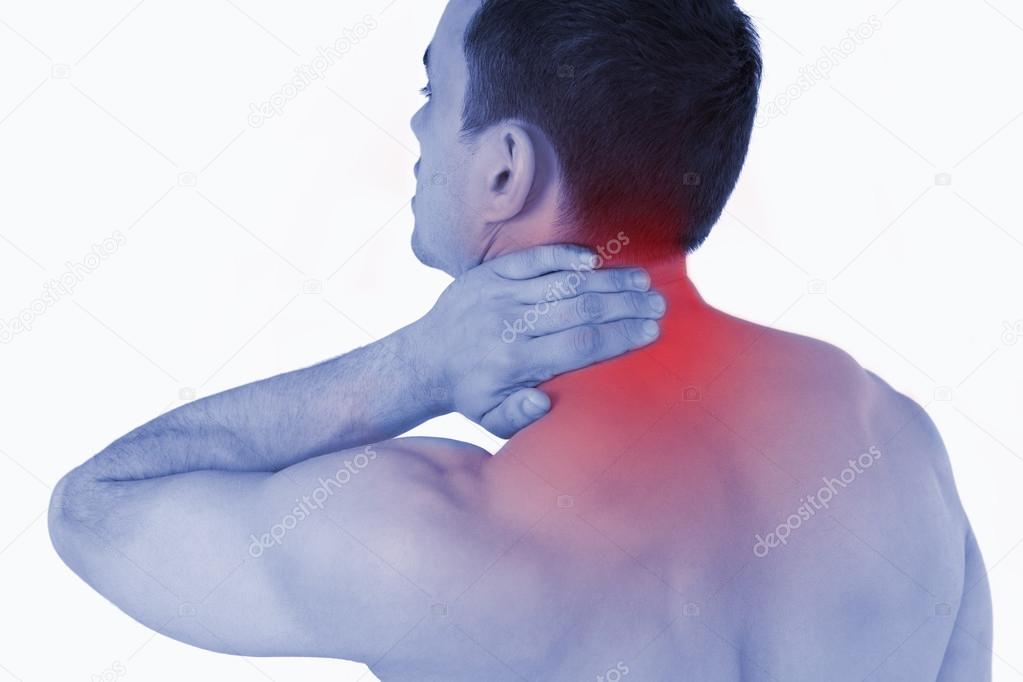 These include:
These include:
- Blood tests
- Imaging tests such as X-rays, CT scans, or MRI exams to make pictures of the inside of your head
It’s best to treat tension headaches soon after they begin, when the symptoms are still mild. The goal is to ease your pain and prevent more of them from happening.
Medications
Over-the-counter (OTC) painkillers are often the first treatments for tension headaches. People with the chronic kind can use some of these drugs to prevent headaches. But if you take them a lot, they can lead to what’s called a medication overuse or rebound headache.
Common OTC treatments include:
- Acetaminophen
- Nonsteroidal anti-inflammatory drugs (NSAIDs) like aspirin, ibuprofen, and naproxen
If OTC pain relievers don’t help, your doctor may prescribe a stronger medicine such as:
- Indomethacin (Indocin, Indochron E-R)
- Ketoprofen
- Ketorolac (Toradol)
- Naproxen (Naprelan, Naprosyn)
They could also recommend a muscle relaxer like:
- Cyclobenzaprine (Amrix, Fexmid)
- Methocarbamol (Robaxin)
Some other kinds of drugs can keep you from getting a tension headache. You take them every day, even if you aren’t in pain, so that you end up using less medication over time. Your doctor may prescribe:
You take them every day, even if you aren’t in pain, so that you end up using less medication over time. Your doctor may prescribe:
- Tricyclic antidepressants like amitriptyline and protriptyline
- Selective serotonin reuptake inhibitors (SSRIs) including fluoxetine (Prozac), paroxetine (Paxil), or venlafaxine (Effexor)
- Anti-seizure drugs such as topiramate (Topamax)
Keep in mind that medications don’t cure headaches and that, over time, pain relievers and other medicines might not help as much as they did at first. Plus, all medicines have side effects. If you take one regularly, talk with your doctor about the pros and cons. You’ll still need to identify and deal with the things that are causing your headaches.
Supplements
Some studies have found that certain dietary supplements are effective against migraine headaches. They may also help prevent tension headaches. These supplements include:
- Butterbur
- Feverfew
- Riboflavin
- Coenzyme Q10
Talk with your doctor before starting any supplements.
Try these treatments to make your headaches less severe or less frequent.
Find ways to relax and manage stress like:
- Biofeedback
- Cognitive behavioral therapy
- Acupuncture
- Massage therapy
- Physical therapy
- Deep breathing
- Meditation
- Yoga
- Hypnotherapy
Lifestyle changes may also help. Consider these:
- Limit stress. Try to plan. Get, and stay, organized. Things that help you relax, like massage or meditation, can also help.
- Try to pace yourself. Take breaks. Carve out time to do things you enjoy. For some people, mindfulness – staying in the here and now, instead of following thoughts of worry and fear – can help.
- Build your support system. Spend time with people you love. You may also want to book some sessions with a therapist to find solutions and to manage any anxiety or depression you may have.
- Exercise regularly.
 At least 30 minutes five times a week is ideal. It eases stress and keeps you fit. It also helps to stretch. Pay close attention to your jaw, neck, and shoulders. These are areas where we tend to hold a lot of tension.
At least 30 minutes five times a week is ideal. It eases stress and keeps you fit. It also helps to stretch. Pay close attention to your jaw, neck, and shoulders. These are areas where we tend to hold a lot of tension. - Get enough sleep. When you’re well-rested, it’s much easier to deal with daily stress.
- Improve your posture. A strong stance can help keep your muscles from tensing. When you stand, hold your shoulders back and your head level. Tighten your belly and buttocks. When you sit, make sure your thighs are parallel to the floor and your head and neck don’t slump forward.
- Drink lots of water. If you’re dehydrated, you’re more likely to get a tension headache. Drink several glasses of fresh water each day, even if you’re not thirsty. It also helps to eat foods that are naturally rich in water, like most fruits and vegetables.
- Eat regular, balanced meals. Skipping a meal can cause a throbbing headache.
 Try to eat at the same times every day. Include plenty of fruits, vegetables, and whole grains in your diet.
Try to eat at the same times every day. Include plenty of fruits, vegetables, and whole grains in your diet. - Limit caffeine and alcohol. There is caffeine in many over-the-counter headache medicines, but it can also trigger headaches. Drink less coffee and tea, and fewer energy and soft drinks.
- Limit how much pain-relieving medication you take. Use the smallest possible dose. Don’t take painkillers more than one or two times a week.
- Keep your sense of humor. It reduces tension.
- Use a headache diary. This will help you spot triggers. It’ll also help your doctor come up with a treatment plan. When you get a headache, note things like the date, the time, any warning signs or other symptoms, the location and intensity of the pain, what you were doing, medications you’d taken, and food you had eaten.
How do you tell them apart?
Tension headaches:
- What do they feel like? Steady, mild to moderate pain that doesn’t throb.
 It can ease or get worse over the course of the headache.
It can ease or get worse over the course of the headache. - Where do they hurt? It can hurt all over your head, but you’ll most likely feel a band of pain around your forehead or the base of your skull or around your neck. The headache does not get worse with activity. Your jaw, shoulders, neck, and head may also be tender.
- Are there any other symptoms? This type of headache doesn’t come with the nausea, vomiting, light sensitivity, or aura that people with migraines have.
- Do you notice symptoms before the headache starts? You might feel stress or tension.
- Who gets them? Mostly adults.
- How often do you get them? It varies.
- How long do they last? Thirty minutes to 7 days.
Migraines:
- What do they feel like? They come on slowly. The pain becomes intense. It can be moderate or severe. It might throb or pulse, and it will get worse with physical activity.

- Where do they hurt? Often, it’s only one side of your head. It might affect your eye, temple, or the base of your skull.
- Are there other symptoms? Some people get a visual disturbance called an aura before the headache starts. During the headache, you might be extra sensitive to light and sound. You might get nauseated and throw up. Some people have trouble moving or speaking.
- Who gets them? Anyone. Boys get them more than girls before puberty But afterward, women get them more than men.
- How often do you get them? It varies.
- How long do they last? Between 4 and 72 hours.
Top Picks
Symptoms, Causes, Treatment, and Prevention
Written by WebMD Editorial Contributors
- What Are Tension Headaches?
- Tension Headache Symptoms
- Tension Headache Causes
- Tension Headache Risk Factors
- When to See Your Doctor
- Tension Headache Diagnosis
- Tension Headache Treatment
- Tension Headache Prevention
- Tension Headaches vs.
 Migraines
Migraines - More
Tension headaches are dull pain, tightness, or pressure that can feel like a clamp squeezing your skull. They’re also called stress headaches, and they’re the most common type for adults.
There are two types:
- Episodic tension headaches happen fewer than 15 days per month.
- Chronic tension headaches happen more than 15 days a month.
These headaches can last 30 minutes to a few days. The episodic kind usually starts slowly, often in the middle of the day.
Chronic ones come and go over a longer period of time. The pain may get stronger or ease up through the day, but it’s almost always there.
Although your head hurts, tension headaches usually don’t keep you from your daily activities, and they don’t affect your vision, balance, or strength.
Where does it hurt?
This type of headache can:
- Start at in one area of your head and spread
- Become a band of dull pressure or squeezing pain around your entire head
- Affect both sides of your head equally
- Make the muscles in your neck, shoulders, and jaw feel tight and sore
Common symptoms include:
- Mild to moderate pain or pressure in the front, top, or sides of your head
- A headache that starts later in the day
- Feeling very tired
- Crankiness
- Trouble focusing
- Mild sensitivity to light or noise
- Muscle aches
Unlike with migraine headaches, you won’t have other nerve symptoms, such as muscle weakness or blurred vision. And tension headaches don’t usually cause severe sensitivity to light or noise, stomach pain, nausea, or vomiting.
And tension headaches don’t usually cause severe sensitivity to light or noise, stomach pain, nausea, or vomiting.
There’s no single cause of tension headaches. They don’t run in families. Some people get them because of tight muscles in the back of the neck and scalp.
Tension headache triggers
Most of the time, tension headaches are triggered by stress from work, school, family, friends, or other relationships.
Episodic ones are usually set off by a single stressful situation or a buildup of stress. Daily stress can lead to the chronic kind.
Tension headache triggers may include:
- Not enough rest
- Poor posture
- Emotional or mental stress, including depression
- Anxiety
- Fatigue
- Hunger
- Low iron levels
- Alcohol
- Jaw or dental problems
- Straining your eyes
- Dehydration
- Skipping meals
- Smoking
- A cold, the flu, or a sinus infection
Up to 80% of adults in the U.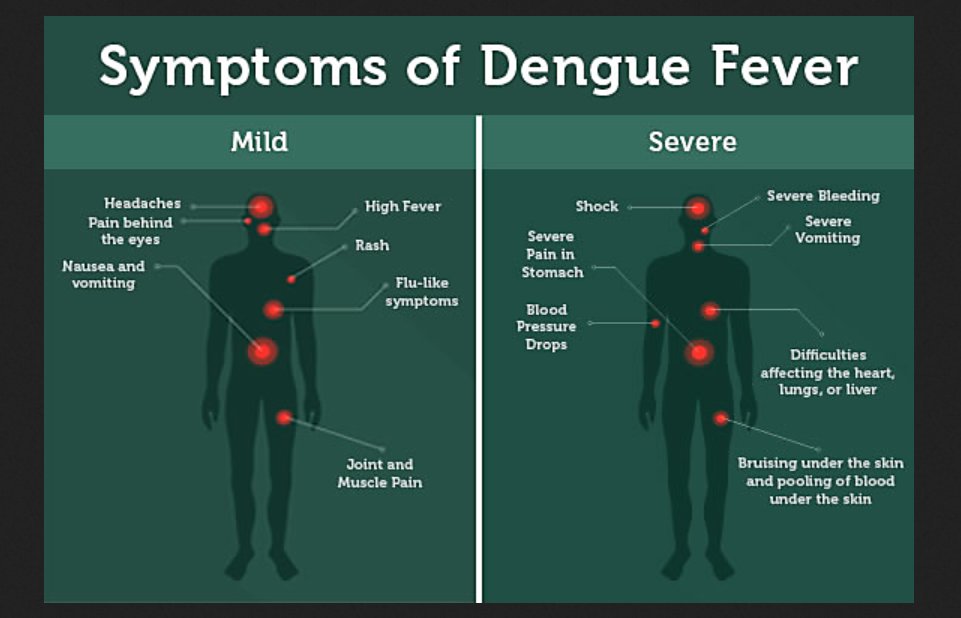 S. get them from time to time. About 3% have chronic daily tension headaches. Women are twice as likely to get them as men.
S. get them from time to time. About 3% have chronic daily tension headaches. Women are twice as likely to get them as men.
Most people with episodic tension headaches have them no more than once or twice a month, but they can happen more often.
Many people with the chronic type have usually had them for more than 60 to 90 days.
See your doctor if you have frequent or severe headaches, or if they get in the way of your daily life.
Call 911 for a headache that is sudden and severe or also makes your face droop, causes weakness or numbness, or makes it hard to talk, see, or think.
Your doctor may diagnose you based only on your symptoms. They might ask you things like:
- Where does your head hurt?
- What does the pain feel like?
- When do you have headaches?
- How long do they last?
- Do your headaches get in the way of your daily life?
- Do they keep you from sleeping?
- Are you under a lot of stress?
- Have you had a head injury?
- Have you noticed any changes in your behavior or personality?
They can also do tests to rule out other conditions. These include:
These include:
- Blood tests
- Imaging tests such as X-rays, CT scans, or MRI exams to make pictures of the inside of your head
It’s best to treat tension headaches soon after they begin, when the symptoms are still mild. The goal is to ease your pain and prevent more of them from happening.
Medications
Over-the-counter (OTC) painkillers are often the first treatments for tension headaches. People with the chronic kind can use some of these drugs to prevent headaches. But if you take them a lot, they can lead to what’s called a medication overuse or rebound headache.
Common OTC treatments include:
- Acetaminophen
- Nonsteroidal anti-inflammatory drugs (NSAIDs) like aspirin, ibuprofen, and naproxen
If OTC pain relievers don’t help, your doctor may prescribe a stronger medicine such as:
- Indomethacin (Indocin, Indochron E-R)
- Ketoprofen
- Ketorolac (Toradol)
- Naproxen (Naprelan, Naprosyn)
They could also recommend a muscle relaxer like:
- Cyclobenzaprine (Amrix, Fexmid)
- Methocarbamol (Robaxin)
Some other kinds of drugs can keep you from getting a tension headache.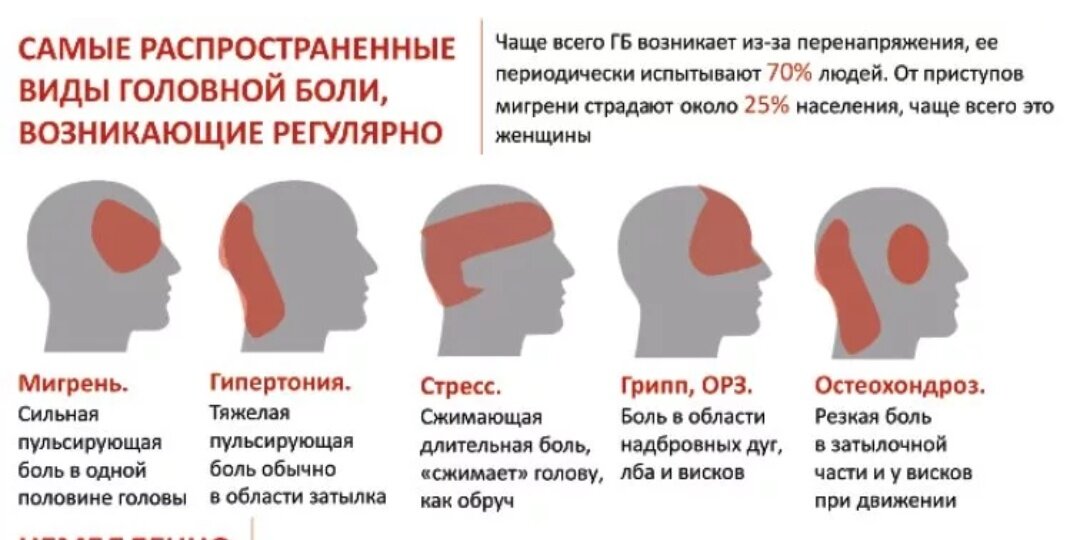 You take them every day, even if you aren’t in pain, so that you end up using less medication over time. Your doctor may prescribe:
You take them every day, even if you aren’t in pain, so that you end up using less medication over time. Your doctor may prescribe:
- Tricyclic antidepressants like amitriptyline and protriptyline
- Selective serotonin reuptake inhibitors (SSRIs) including fluoxetine (Prozac), paroxetine (Paxil), or venlafaxine (Effexor)
- Anti-seizure drugs such as topiramate (Topamax)
Keep in mind that medications don’t cure headaches and that, over time, pain relievers and other medicines might not help as much as they did at first. Plus, all medicines have side effects. If you take one regularly, talk with your doctor about the pros and cons. You’ll still need to identify and deal with the things that are causing your headaches.
Supplements
Some studies have found that certain dietary supplements are effective against migraine headaches. They may also help prevent tension headaches. These supplements include:
- Butterbur
- Feverfew
- Riboflavin
- Coenzyme Q10
Talk with your doctor before starting any supplements.
Try these treatments to make your headaches less severe or less frequent.
Find ways to relax and manage stress like:
- Biofeedback
- Cognitive behavioral therapy
- Acupuncture
- Massage therapy
- Physical therapy
- Deep breathing
- Meditation
- Yoga
- Hypnotherapy
Lifestyle changes may also help. Consider these:
- Limit stress. Try to plan. Get, and stay, organized. Things that help you relax, like massage or meditation, can also help.
- Try to pace yourself. Take breaks. Carve out time to do things you enjoy. For some people, mindfulness – staying in the here and now, instead of following thoughts of worry and fear – can help.
- Build your support system. Spend time with people you love. You may also want to book some sessions with a therapist to find solutions and to manage any anxiety or depression you may have.
- Exercise regularly.
 At least 30 minutes five times a week is ideal. It eases stress and keeps you fit. It also helps to stretch. Pay close attention to your jaw, neck, and shoulders. These are areas where we tend to hold a lot of tension.
At least 30 minutes five times a week is ideal. It eases stress and keeps you fit. It also helps to stretch. Pay close attention to your jaw, neck, and shoulders. These are areas where we tend to hold a lot of tension. - Get enough sleep. When you’re well-rested, it’s much easier to deal with daily stress.
- Improve your posture. A strong stance can help keep your muscles from tensing. When you stand, hold your shoulders back and your head level. Tighten your belly and buttocks. When you sit, make sure your thighs are parallel to the floor and your head and neck don’t slump forward.
- Drink lots of water. If you’re dehydrated, you’re more likely to get a tension headache. Drink several glasses of fresh water each day, even if you’re not thirsty. It also helps to eat foods that are naturally rich in water, like most fruits and vegetables.
- Eat regular, balanced meals. Skipping a meal can cause a throbbing headache.
 Try to eat at the same times every day. Include plenty of fruits, vegetables, and whole grains in your diet.
Try to eat at the same times every day. Include plenty of fruits, vegetables, and whole grains in your diet. - Limit caffeine and alcohol. There is caffeine in many over-the-counter headache medicines, but it can also trigger headaches. Drink less coffee and tea, and fewer energy and soft drinks.
- Limit how much pain-relieving medication you take. Use the smallest possible dose. Don’t take painkillers more than one or two times a week.
- Keep your sense of humor. It reduces tension.
- Use a headache diary. This will help you spot triggers. It’ll also help your doctor come up with a treatment plan. When you get a headache, note things like the date, the time, any warning signs or other symptoms, the location and intensity of the pain, what you were doing, medications you’d taken, and food you had eaten.
How do you tell them apart?
Tension headaches:
- What do they feel like? Steady, mild to moderate pain that doesn’t throb.
 It can ease or get worse over the course of the headache.
It can ease or get worse over the course of the headache. - Where do they hurt? It can hurt all over your head, but you’ll most likely feel a band of pain around your forehead or the base of your skull or around your neck. The headache does not get worse with activity. Your jaw, shoulders, neck, and head may also be tender.
- Are there any other symptoms? This type of headache doesn’t come with the nausea, vomiting, light sensitivity, or aura that people with migraines have.
- Do you notice symptoms before the headache starts? You might feel stress or tension.
- Who gets them? Mostly adults.
- How often do you get them? It varies.
- How long do they last? Thirty minutes to 7 days.
Migraines:
- What do they feel like? They come on slowly. The pain becomes intense. It can be moderate or severe. It might throb or pulse, and it will get worse with physical activity.

- Where do they hurt? Often, it’s only one side of your head. It might affect your eye, temple, or the base of your skull.
- Are there other symptoms? Some people get a visual disturbance called an aura before the headache starts. During the headache, you might be extra sensitive to light and sound. You might get nauseated and throw up. Some people have trouble moving or speaking.
- Who gets them? Anyone. Boys get them more than girls before puberty But afterward, women get them more than men.
- How often do you get them? It varies.
- How long do they last? Between 4 and 72 hours.
Top Picks
Headaches in children and their types.
 Treatment and causes.
Treatment and causes.
WHAT IS HEADACHES?
Headache is pain or discomfort in the head or face. Headaches can be single or recurring in nature and localized in one or more areas of the head and face.
WHAT CAUSES A HEADACHE?
The exact cause of a headache is not always clear. It is generally accepted that most headaches are associated with tension in the muscles of the skull and cervical region or expansion / constriction of the blood vessels of the head. While migraine was previously thought to be related to dilated blood vessels in the head, recent evidence suggests that it is related to neurotransmitter disturbances in the brain and electrical signaling in brain cells.
Some of the headaches are associated with a violation of the connections between the parts of the nervous system responsible for the transmission of nerve impulses from the head, face and cervical region.
Lack of sleep and poor sleep quality are often the cause of chronic headaches.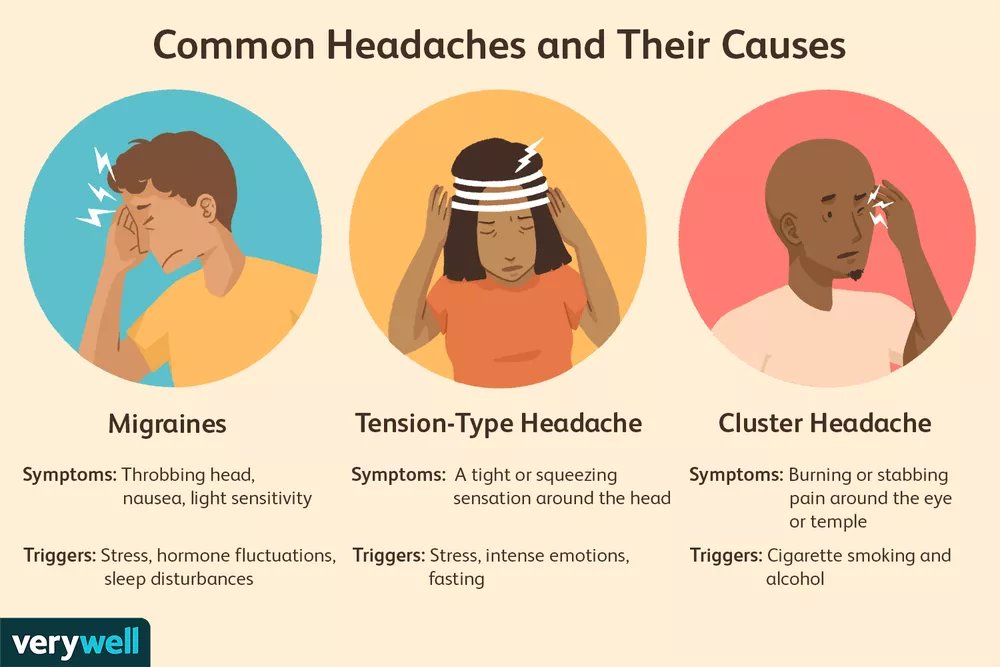
In some cases, a specific cause causes a headache, such as a tumor or malformation of cerebral vessels.
WHAT TYPES OF HEADACHES ARE THERE?
There are many classifications of headaches. One of the main divides headaches by primary and secondary .
PRIMARY HEADACHES
This type of headache is usually caused by tense muscles, dilated blood vessels, disruption of the relationship between parts of the nervous system or inflammation of some structures in the brain and is not associated with other medical conditions. The following types of primary headaches are distinguished:
Migraine
Migraine can begin in early childhood. Approximately 20% of teenagers have migraine headaches. The average age of onset is 7 years for boys and 10 years for girls. Often there is a hereditary burden for migraine. For some women, headache correlates with menstruation. Each child may show different migraine symptoms, but in general they are as follows:
Each child may show different migraine symptoms, but in general they are as follows:
- Headache on one or both sides of the head
- Headache throbbing (although young children cannot describe pain)
- Sensitivity to light and sound
- Nausea and/or vomiting
- Discomfort in the stomach dke
- Sweating
- Child with migraine looks quiet and pale
- Some children experience a pre-migraine aura in the form of flickering lights, blurred vision, strange smells.
Tension headaches
D Tension headaches are the most common type of headache. Stress, mental tension, conflicts are often triggers for tension headaches. All children experience this type of pain differently, but common symptoms are:
- Slow onset of pain
- Headache on both sides
- Head aching or sensation of a band pulling down on the head
- Head involving the back of the head and neck
- Pain is mild to moderate but not severe
- Sleep disturbance in children
- Children with tension headaches do not experience nausea, vomiting, or sensitivity to light.

Cluster headaches
Cluster headaches occur in children older than 10 years, and are more common in adolescent boys. They are much less frequent than migraine or tension headaches. Cluster cluster headaches occur in the form of series lasting weeks or months, and these series of headaches can occur every year or every 2 years. The most common symptoms of cluster (bundle) headache are:
- Acute pain on one side of the head, usually behind one eye
- Side of involved eye may have drooping eyelid, small pupil, redness, eyelid inflammation
- Nasal discharge
- Inflammation of frontal region
SECONDARY HEADACHES
This type of headache is the result of organic brain damage (problems in the structure of the brain) due to the current disease and is a rarer type of headache.
WHAT TYPE OF HEADACHES IS ASSOCIATED WITH SERIOUS DISEASES?
Typical symptoms of headaches associated with more serious illnesses can be
- Onset of headache at a very early age
- Awakening of a child from severe headache
- Headaches that occur very early in the morning
- Repeated episodes of vomiting that are not accompanied by other symptoms (nausea) or current illness
- Lightning onset with unbearable intensity
- Headache with progression in severity and duration
- Personality changes that occurred simultaneously with the onset of headache
- Visual impairment parallel to the onset of headache
- Weakness in limbs and unsteady gait 9 0044
- Presence of epileptic seizures
9 0043 Headaches aggravated by background straining (coughing or sneezing)
Headache in children may resemble other diseases, always consult your doctor.
HOW IS HEADACHE DIAGNOSED?
In the presence of a headache, it is not always possible to assess the completeness of the problem. To make a diagnosis, the doctor will carefully evaluate the complaints and the history of the disease, examine the child neurologically and prescribe additional research methods (MRI, CT, EEG, ultrasound laboratory tests). At the consultation, doctors usually ask the following questions:
- When did the headaches start
- In what part of the head is the pain localized
- How does the headache feel (characteristics)
- How long does the headache last?
- Is there any disturbance in gait, behavior, personality? at emotional stress of the child
- Has there been a recent history of facial and head injuries
0007
Otherwise, you may need:
- Blood tests. Including CBC, iron level, ferritin level, thyroid hormones
- MRI.
 Method using a large magnet to obtain a detailed image of the organs of the body and brain of the patient organs, )
Method using a large magnet to obtain a detailed image of the organs of the body and brain of the patient organs, ) - Polysomnography: A painless test performed while you sleep. Special sensors during the study evaluate breathing and muscle movements. This study is being conducted in children with suspected sleep disorders (sleep apnea) and other sleep-related problems.
- Ultrasound of the vessels of the brain in some cases, we need an image of the vessels obtained on an ultrasound machine in order to assess the speed of blood flow and the presence of spasm of the arteries and veins of the head
HEADACHE TREATMENT
Treatment for a specific type of headache will be determined by your child’s primary care physician based on the following information:
- Child’s age, general health, medical history
- Duration severity and severity of headache
- Headache type pain
- Child’s tolerance to specific procedures, preparations, methods of influence
- Your opinion and preferences
The main goal of treatment is to prevent the recurrence of headache attacks. Treatment depends on correct identification of the type of headache and may include:
Treatment depends on correct identification of the type of headache and may include:
- Rest in a calm, quiet room
- Medication
- Stress management (psychotherapy, rest, stress reduction)
- Avoidance of typical triggers (specific foods and drinks, lack of sleep, fasting)
- Changes in diet
- Sports and special exercises (yoga, exercise therapy)
Migraine headaches may require specific medications including:
- Drugs that interrupt the attack: drugs prescribed by your doctor that act on receptors in the blood vessels of the head and can interrupt the migraine attack
- Drugs ambulance (symptomatic treatment ) : over-the-counter medicines, such as analgesics, to stop pain.
- Prophylactic drugs: Medicines prescribed by your child’s doctor to prevent severe migraine attacks
Some headaches may require immediate medical attention, including hospitalization for observation, diagnostic tests, and even surgery. Treatment is highly individualized depending on the severity of the underlying condition. The degree and speed of recovery of the child depends on the type of headache and concomitant diseases.
Treatment is highly individualized depending on the severity of the underlying condition. The degree and speed of recovery of the child depends on the type of headache and concomitant diseases.
Benefits of treatment at the NET clinic
Comprehensive neurological care for children from birth and adults
Modern methods of treatment of developmental delays
Doctors of the highest category with many years of experience
Diagnostics on expert-class equipment
Individual rehabilitation programs
Clinical base of the Department of Pediatric Neurology
Specialists
Neurologist, osteopath
Safina Aigul Munirovna
Experience 3 years
| Pediatric neurologist consultation | 1200 |
| Osteopathy – children aged 4 to 18 | 2500 |
| Osteopathy – adults | 2500 |
More
Neurologist, highest category
Lira Natalya Vasilievna
Experience 34 years
| Consulting | 1500 |
| Taping (tape length up to 50 cm) | 500 |
More
Mubarakshina Aisulu Revalevna
Experience 31 years
| Head and neck ultrasound | 2000 |
| Ultrasound of the vessels of the head and neck separately | to 1000 |
| Ultrasound of the brain through the fontanel | 700 |
| Abdominal ultrasound | 630 |
More
The following services may help with these symptoms
Neurology
Treatment:
– Headaches
– Dizziness
– Fainting
– Pain in the face, neck, back, limbs, whole body
– Muscle weakness
– Disorders of sleep, speech, memory, concentration
– Numbness in limbs
– Consequences of stroke
– Dementia
– Cerebral ischemia
Read more
Diagnostic Ultrasound
Diagnostics:
– Headaches
– Fainting
– Decreased vision
– Difficulty concentrating
– Hyperactivity
– Suspected hip dysplasia
– Abdominal symptoms
– Feeling weak, tired, constipated, abdominal pain
— Suspicion of thyroid pathology
Read more
Physiotherapy
Indications:
– Functional disorders of the central, autonomic and peripheral nervous system
– Dysfunction of internal organs
– Inflammatory diseases
– Traumatic injuries
– Metabolic and dystrophic diseases
Contraindications:
– Hyperthermia
– Hemorrhagic, myeloplastic, hemolytic syndromes
– Acute purulent processes, skin diseases
– Ser degenerative, vascular, respiratory, liver, kidney failure in the phase of decompensation
— Malignant neoplasms
Read more
Making an appointment
Why does my head hurt and when should I sound the alarm?
Headache is one of the most common complaints that patients seek medical care for.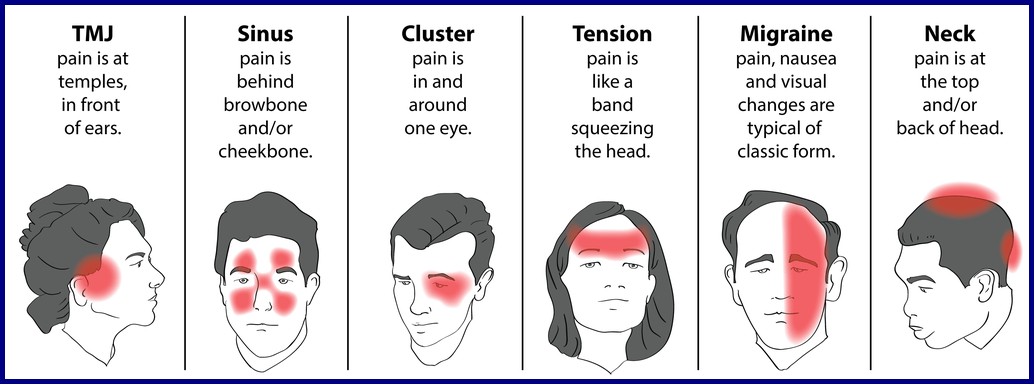 The World Health Organization (WHO) estimates that about half of the world’s adult population suffers from this problem every year. Why does my head hurt, and in what cases should I immediately consult a doctor? You will learn about this from this article.
The World Health Organization (WHO) estimates that about half of the world’s adult population suffers from this problem every year. Why does my head hurt, and in what cases should I immediately consult a doctor? You will learn about this from this article.
Pain in the head and face varies greatly depending on their location, intensity and frequency. Brain tissues do not have nerve fibers sensitive to pain, therefore they are not able to perceive pain. Other parts of the head are responsible for frequent headaches, including:
- Network of nerves that extend over the scalp,
- Some nerves in the face, mouth and throat,
- Muscles of the head, neck and shoulders,
- Blood vessels that are located along the surface of the brain and at its base.
Why does my head hurt?
This unpleasant phenomenon can be caused by many factors: stress, depression or some kind of disease, for example, migraine or hypertension.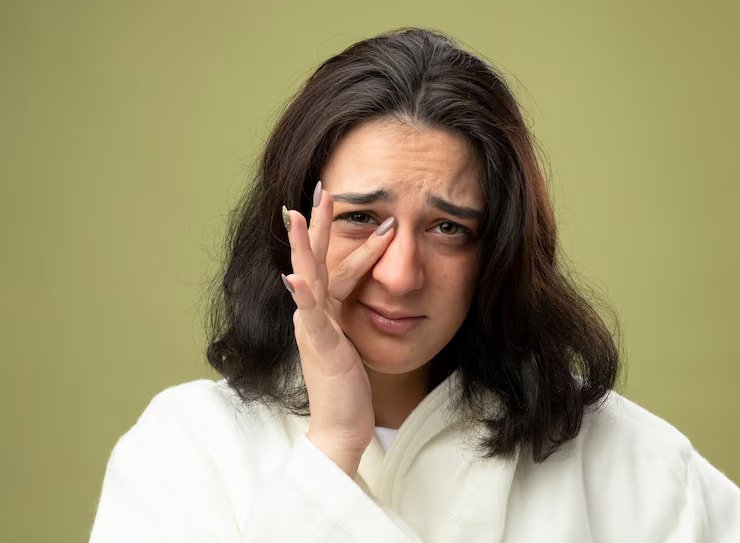 Pain can appear in any part of the head – on both sides of it or only in one area. It can be acute, pulsating or dull, and lasts from several tens of minutes to several days. The exact causes of headaches depend on the type of headache. Below we will look at the most common of them.
Pain can appear in any part of the head – on both sides of it or only in one area. It can be acute, pulsating or dull, and lasts from several tens of minutes to several days. The exact causes of headaches depend on the type of headache. Below we will look at the most common of them.
D Tension headache
This is the most common pain and is often triggered by stress, tight muscles in the back of the neck, prolonged fasting and dehydration. Its characteristic symptoms are:
- Appears gradually,
- As a rule, it spreads to both sides of the head, sometimes extends to the back of the head or neck,
- The nature of the pain is dull, sometimes it seems as if a bandage or vise is squeezing the head,
- The pain is mild or moderate, but not severe.
In most cases, episodic tension-type headache lasts about 30 minutes, but sometimes it haunts a person for several days. If the pain is chronic, it bothers at least 15 days a month for at least 3 months.
How to get rid of a tension headache? It is “removed” by the usual painkillers – paracetamol and ibuprofen, which are washed down with a large glass of water. Sleeping on a low pillow, limiting coffee intake, and drinking adequate fluids also help.
Migraine
This common type of pain is accompanied by additional symptoms: nausea and vomiting, dizziness, increased sensitivity to light. Migraine headache manifests itself in the form of unilateral throbbing pain. Deep in the brain, a mechanism is triggered that releases inflammatory substances around the nerves and blood vessels of the head, which leads to painful sensations.
Often the pain is so severe that it can put a person out of action. Some people need to sleep to get rid of it. A severe headache lasts from a few hours to three days and gets worse when the person moves and is also affected by sound or light. Most people get migraines 1-2 times a month.
About a third of people who suffer from this type of pain experience what is known as a “classic migraine”. In this case, before the pain attack, warning symptoms appear in the form of flashing lights in a zigzag shape, which are sometimes described as fireworks. As a rule, these lights appear only on one side, although they affect both eyes at the same time. Some people also experience other warning symptoms of a migraine headache, such as loss of vision in one eye, tingling, and difficulty speaking. All these symptoms can last up to an hour, after which a migraine appears.
In this case, before the pain attack, warning symptoms appear in the form of flashing lights in a zigzag shape, which are sometimes described as fireworks. As a rule, these lights appear only on one side, although they affect both eyes at the same time. Some people also experience other warning symptoms of a migraine headache, such as loss of vision in one eye, tingling, and difficulty speaking. All these symptoms can last up to an hour, after which a migraine appears.
This type of pain is triggered by stress, hunger, certain foods (chocolate and red wine), fatigue and lack of fluid in the body. Most often migraine affects women aged 35-45 years.
Rest, sleep, darkness and silence improve a person’s well-being. Paracetamol and ibuprofen help relieve the condition, although many do not get any effect from them. In this case, the treatment of migraine requires special medications that are prescribed only by prescription.
Cluster headache
This type of headache is relatively rare, as the World Health Organization estimates that it affects less than 1 in 1,000 people. Men are affected 5-6 times more often than women. The pain is extremely severe, often recurring (up to several times a day), although short in duration. It is because of the recurring attacks that this kind of pain is called “cluster” (series – clusters).
Men are affected 5-6 times more often than women. The pain is extremely severe, often recurring (up to several times a day), although short in duration. It is because of the recurring attacks that this kind of pain is called “cluster” (series – clusters).
Cluster headache is localized in one eye or in the area around it. A person has tearing and redness of the eye, and the eyelid may sag. Also, the patient lays one nostril on the affected side of the head, and sometimes copious discharge comes from the nose. Studies show that one of the causes of this type of headache is a genetic factor. Often she torments adult male smokers, as well as lovers of alcohol.
This very severe headache may persist for several days or even weeks, after which it disappears for a couple of months. Cluster pain is not in vain called “suicidal pain”, because sometimes a person thinks about committing suicide in order to get rid of it. How to get rid of a cluster type headache? A person has only one option – to contact a neurologist, who will prescribe pills or an oxygen inhaler.
Medications
Headaches are among the side effects of many medications. Although it seems paradoxical, overuse of headache medications can also cause headaches to reappear.
How to cure a headache caused by medication? Unfortunately, the only way out is to stop taking painkillers for at least 1 month. This means that a person will have to endure. Sometimes doctors prescribe corticosteroids, which temporarily replace painkillers, for the period of stopping medication for pain in the head.
If your head hurts, is it something serious?
In most cases, there is no cause for concern, but sometimes a headache can be a sign of dangerous conditions such as a stroke, meningitis, or a brain tumor. The following manifestations of pain act as a cause for concern and a visit to a neurologist or therapist:
- Over time, the pain does not go away and intensifies.
- Pain appeared after a severe head injury.


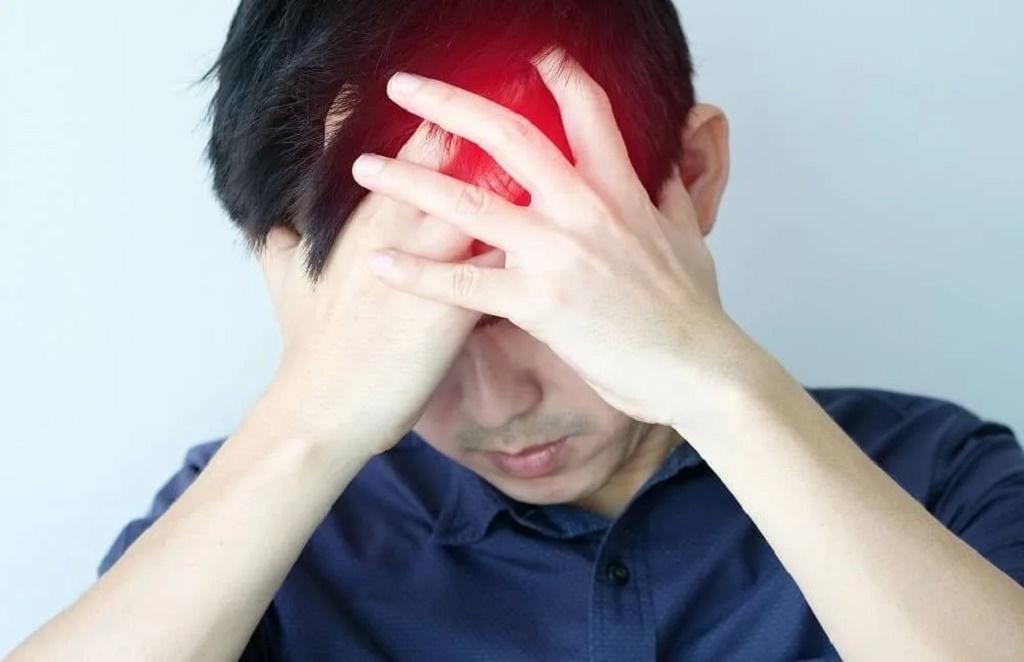 At least 30 minutes five times a week is ideal. It eases stress and keeps you fit. It also helps to stretch. Pay close attention to your jaw, neck, and shoulders. These are areas where we tend to hold a lot of tension.
At least 30 minutes five times a week is ideal. It eases stress and keeps you fit. It also helps to stretch. Pay close attention to your jaw, neck, and shoulders. These are areas where we tend to hold a lot of tension. Try to eat at the same times every day. Include plenty of fruits, vegetables, and whole grains in your diet.
Try to eat at the same times every day. Include plenty of fruits, vegetables, and whole grains in your diet. It can ease or get worse over the course of the headache.
It can ease or get worse over the course of the headache.
 Migraines
Migraines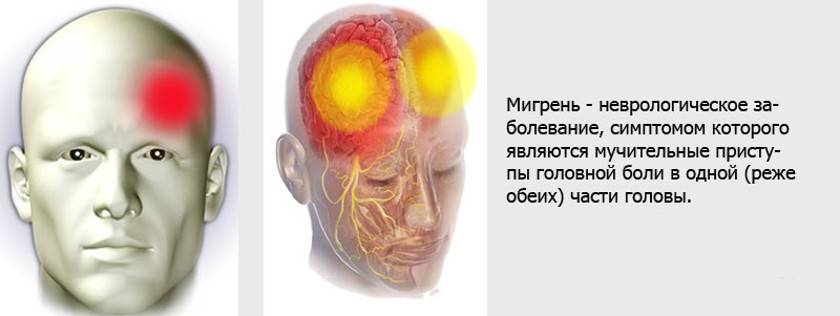 At least 30 minutes five times a week is ideal. It eases stress and keeps you fit. It also helps to stretch. Pay close attention to your jaw, neck, and shoulders. These are areas where we tend to hold a lot of tension.
At least 30 minutes five times a week is ideal. It eases stress and keeps you fit. It also helps to stretch. Pay close attention to your jaw, neck, and shoulders. These are areas where we tend to hold a lot of tension.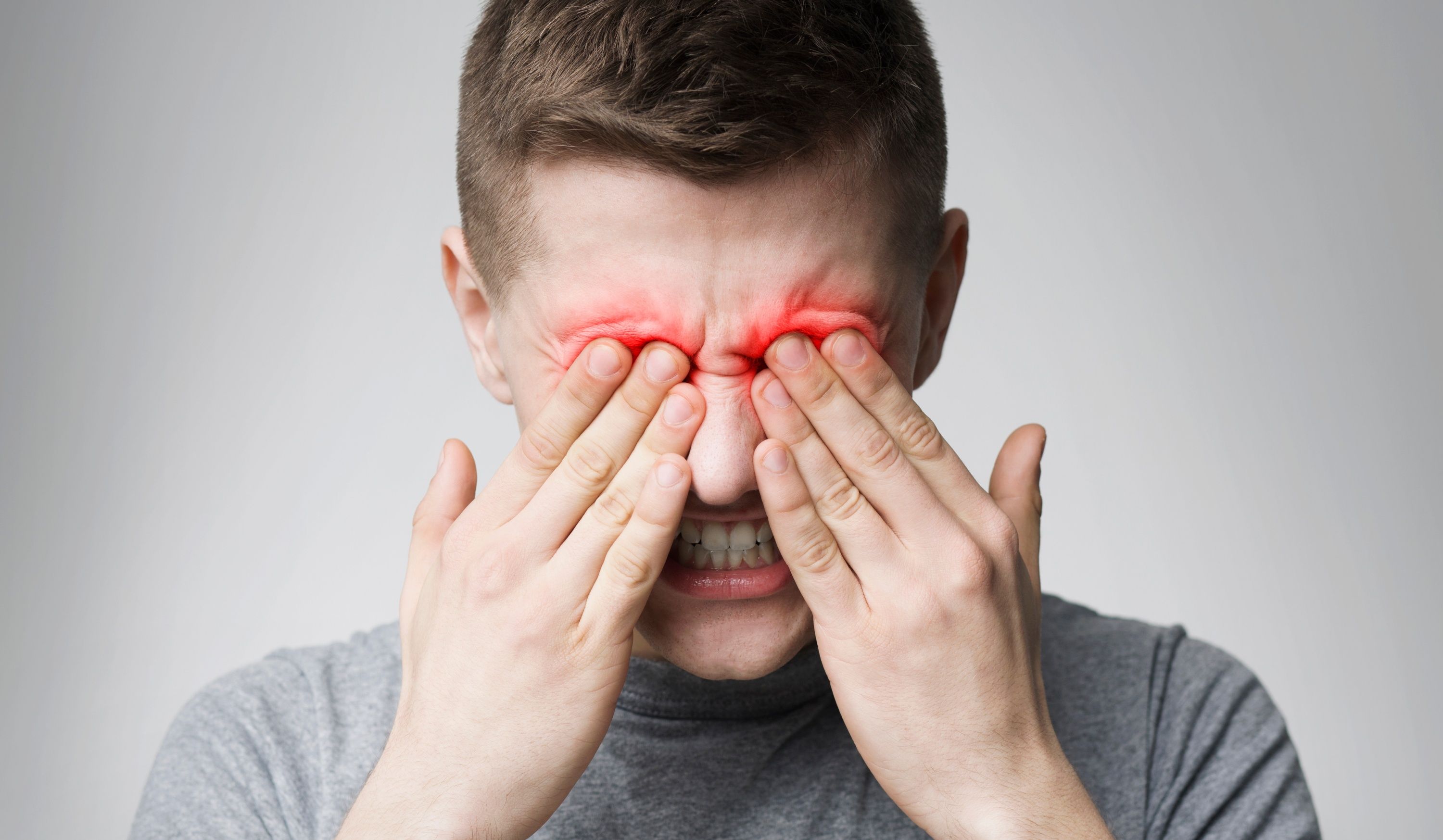 Try to eat at the same times every day. Include plenty of fruits, vegetables, and whole grains in your diet.
Try to eat at the same times every day. Include plenty of fruits, vegetables, and whole grains in your diet.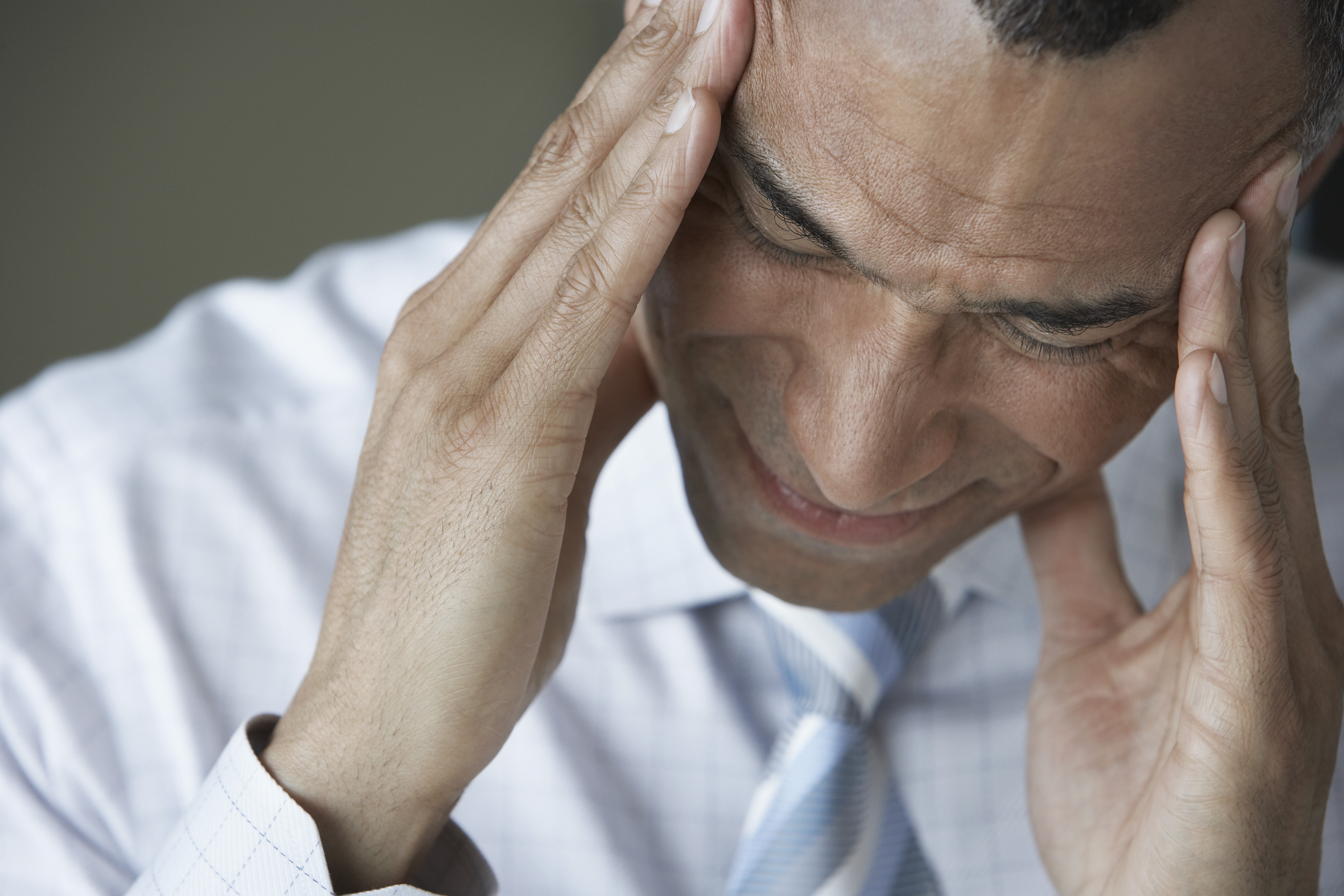 It can ease or get worse over the course of the headache.
It can ease or get worse over the course of the headache.

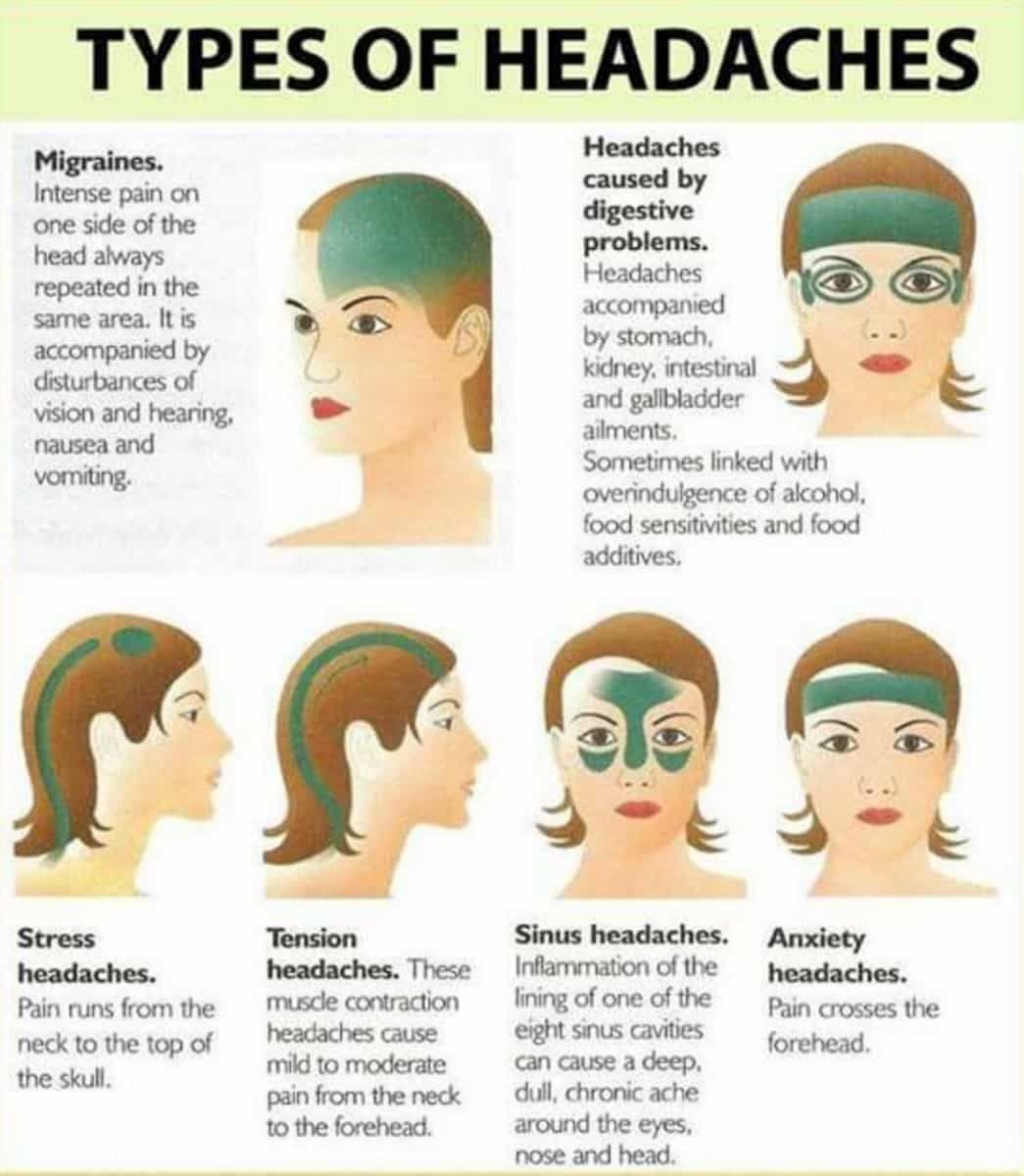 Method using a large magnet to obtain a detailed image of the organs of the body and brain of the patient organs, )
Method using a large magnet to obtain a detailed image of the organs of the body and brain of the patient organs, )